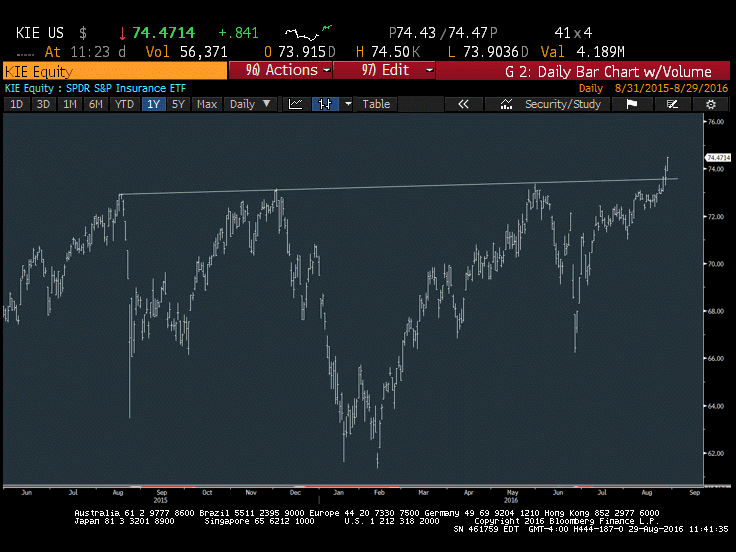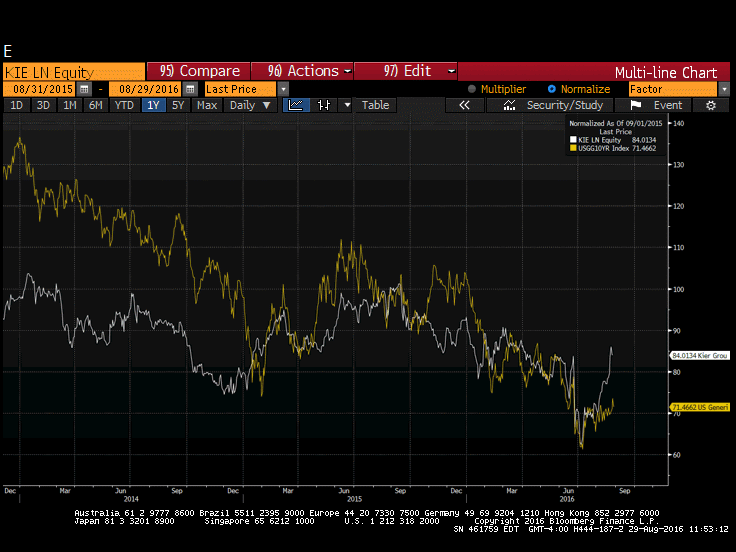Possible interest rate hikes? No hurricanes? No problem. Insurance stocks are breaking out and new all-time highs may just be the start.
We’ve heard about the drought in Hurricanes over the last 10 years, with no major hurricanes (Category 3 or above) making landfall since 2005. Sure enough, we’ve seen a relatively calm season thus far again this year. As well, interest rates are starting to tick higher gradually on fears that the market has gotten behind the curve (regarding the Federal Reserve’s normalization plans).
This has been a boon for Insurance stocks and the S&P Insurance Sector ETF (NYSEARCA:KIE), as they represent one group of the Financial Sector (NYSEARCA:XLF) that broke out to new all-time highs last week (see chart of KIE). Insurance stocks were largely overshadowed by anticipation over Jackson Hole.
However, following Yellen’s near-term Hawkishness in trying to prepare the market for a possible September interest rate hike, we saw above-average relative strength in both the Life/Health Insurance sector and Property Casualty Insurance sector. Needless to say, KIE vaulted back to new all-time highs. While Property and Casualty stocks have outperformed Life and Health steadily over the last year, Life and Health stocks have made a formidable comeback. Insurance stocks like Principal Financial Group (PFG), Aflac (AFL), and and Torchmark Corp (TMK) all returning greater than 5% in YTD terms.
The KIE meanwhile has been on a tear, up 2.4% for the month of August with two trading days left to go. While this achievement has lagged the broader Financials space, there are signs that this could change given KIE’s move back to new all-time high territory. As the charts of the KIE show, this move just exceeded May 2016 highs at 73.36 which had previously been repelled (right near both November and August highs from 2015). Thus, this breakout has successfully exceeded three “prominent” highs in the last year which had held as serious resistance (I say Prominent given that each peak was followed by at least a 9% correction or more). Thus, it’s likely that this move leads to further intermediate-term gains and acceleration for many of the stocks which have not yet experienced breakouts of the sort.
Some may look at this breakout in insurance stocks with frustration, thinking they missed it. Note 77% of active managers Year to Date have underperformed the market – as the saying goes, “Sometimes it’s wise to chase after that fleeting horse out of the barn, and climb aboard”. At the same time, we must also stay true to our individual trading styles/risk profiles.
The S&P 500 Life and Health Insurance Index, for example, just broke out of a 1 year downtrend. Yet, at the same time, it remains over 12% off its all-time highs (made last June). Property and Casualty stocks, meanwhile have continued their ascent in steady, and non-parabolic fashion over the years.
Technically speaking, there are several insurance stocks that could see above-average appreciation. The following are 10 stocks that stand out to me:
Aflac (AFL), Cincinnati Financial Corp (CINF), Marsh and Mclennan (MMC), Gallagher Arthur J & Co (AJG), AON Corp (AON), Assurant (AIZ), which have all shown above-average performance YTD, but have consolidated sideways in the last 1-2 months. These are now starting to turn higher to challenge recent highs, and look like attractive technical risk/reward candidates.
Arch Capt. Grp (ACGL), First American (FAF), ProAssurance Corp (PRA) and Torchmark (TMK) are four more names to round out the 10 Insurance stocks which have been stronger than normal in the last month. Technically, they still appear quite attractive based on my own proprietary methods of viewing their technical structure.
Here are several charts to highlight the strength in this sector (and stocks). Charts created on Bloomberg.
S&P Insurance Sector ETF (KIE) – Breakout has exceeded three prior highs, starting with the peak last August. While near-term overbought, this is a technically bullish intermediate-term move.
KIE has largely trended in-line with interest rates and given the recent uptick, has also responded quite positively.
continue reading on the next page…










